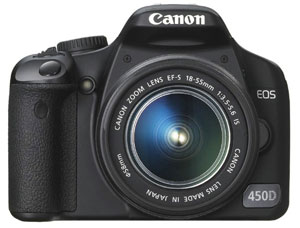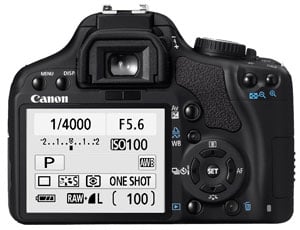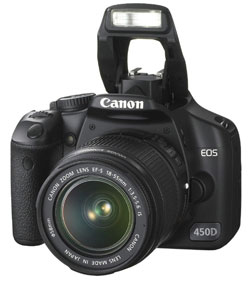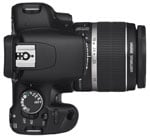Canon EOS 450D / Digital Rebel XSi
-
-
Written by Gordon Laing
Canon EOS 450D / Rebel XSi verdict
The Canon EOS 450D / Rebel XSi is a powerful DSLR for the money and a worthy successor to the best-selling EOS 400D / XTi. Canon has sensibly followed Nikon’s winning strategy for the D80 and instead of aiming at the lowest price-point, has gone for a more upmarket model with a design and feature-set that will appeal to those who may still be budget-conscious, but see the value of something a little bit classier.
So with the new 450D / XSi you get a number of worthwhile upgrades over its predecessor beyond the inevitable increase in resolution and screen size. You get Live View, a kit lens with Image Stabilisation, a bigger optical viewfinder which shows the ISO value at all times, slightly quicker continuous shooting, spot metering, a new battery with longer life, a dedicated ISO button, and a raft of processing options inherited from the higher-end EOS-40D including 14-bit A-D conversion and Highlight Tone Priority. You also get software which allows you to remote control the camera over a USB cable from a PC or Mac, including the ability to preview a live image on your monitor and even focus the lens. And while many traditional photographic controls are being neglected on rival models, it’s great to still find a depth-of-field preview button and mirror lockup functions on the 450D / XSi. It’s a small point, but the new two second self-timer is also appreciated.

 | |
| ||
Pick up the 450D / XSi and your first impression is one of a surprisingly light camera – indeed it’s noticeably lighter and thinner than its arch rival, the Sony Alpha A350. Some undoubtedly prefer the reassurance of a bigger, heavier camera, but we’ve no complaints about the build quality of the new Canon and anyone hiking or travelling light will appreciate its low size and weight.
In use, the 450D / XSi feels very responsive and quicker than its predecessor. The viewfinder is visibly a little bigger than the 400D / XTi, which itself is bigger than the Sony A350’s. The continuous shooting may only be half a frame per second faster than the 400D / XTi, but you really do get 3.5fps in practice and it’s much quicker than the 2.35fps reality of the A350.
In terms of image quality, Canon has struck a sensible balance between marketing demands of increasing the resolution, while attempting to maintain noise levels. As our results pages show, there may not be much difference in the real-life detail recorded by 10 and 12 Megapixel DSLRs, but at least the noise levels remain pretty much matched to the earlier 400D / XTi – which gives both cameras an advantage over the Sony A350 which appears noisier than the Canons at higher sensitivities. The 450D / XSi also seems to avoid the underexposures which affected its predecessor, while the 14-bit conversion and RAW files give you plenty of latitude for tonal adjustments. We would however say the 450D / XSi’s default output could benefit from a little boost in sharpening.
So far you’d think Canon’s scored a slam-dunk over Sony, but that’s not the whole story. Sony’s Alpha DSLRs of course have built-in stabilisation which works with any lens you attach and the company has also opted for a strikingly different Live View implementation. With the 450D / XSi, Canon’s gone for a traditional approach which uses the main sensor to deliver the Live View. The pros include 100% coverage, magnified manual focus assistance and depth of field previews, so what you see really is what you’re going to get.
The downside is bypassing the traditional AF system. So Canon gives you two choices: either suffer a delay, some noise and a temporary interruption as the mirror flips down and up again, or go for the new contrast-based ‘Live’ option which won’t interrupt the view or make any noise, but which is even slower.
In contrast, Sony’s new Live View system on the A350 (and A300) uses a secondary sensor in the viewfinder. You can switch between using the viewfinder and Live View quietly and almost instantly, and crucially the AF system isn’t bypassed so the camera focuses at the same speed in Live View and without interruption. Cleverly, Sony’s mechanical switch also closes a shutter in the viewfinder when you switch to Live View – very considerate. Best of all, the screen tilts out for easier framing at high or low angles.
But on the downside, by not using the main sensor, Sony’s system only delivers 90% coverage – that’s even less than the viewfinder. There’s also no magnified manual focus assistance, nor the ability to overlay graphics like an alignment grid; you can’t even see a preview of the camera’s sensor-shift stabilisation. The internal arrangement additionally compromises the size of the optical viewfinder and the height at which the internal flash can popup.
So there’s pros and cons to both systems. If you want fuss-free Live View, quick AF and the closest thing to a point and shoot experience, then Sony’s system is undoubtedly better. But if you use Live View for precision work like architectural, macro or astro-photography, then the technical benefits of Canon’s system will be preferred.
So before wrapping-up, how does Canon’s latest DSLR compare to its rivals?
Compared to Canon EOS 400D / Rebel XTi
The camera which will most be compared against the EOS 450D / XSi is its predecessor the 400D / XTi. Predecessor is a slightly unfair term though as Canon’s keeping the 400D / XTi in its range as its entry-level model, with the new 450D / XSi designed as a step-up model. In its favour, the new 450D / XSi features two extra Megapixels, Live View, a slightly bigger 3in screen, and a kit lens with Image Stabilisation. Beyond this you also get an improved viewfinder, spot-metering, 14-bit processing, slightly quicker 3.5fps continuous shooting and PC remote control software, along with what’s arguably a better-looking body. Together these all add up to a superior camera, but you may not want or need the new features. As we’ve illustrated, the jump from 10 to 12 Megapixels is smaller in real-life than you might think. The new stabilised kit lens is certainly welcome, but you could of course buy a different – and better – lens with IS instead. The bigger screen, 3.5fps shooting and improved processing are all nice, but hardly deal-breakers not to have them. Of course everyone places different weightings on new features, but arguably the most important on the 450D / XSi is the inclusion of Live View. Ultimately you have to decide for yourself if you’d make use of the new features, and whether they’re worth spending the extra. The 400D / XTi kit is currently available at decent prices, and remember if you went for the body alone, you could buy it with the far superior EF-S 17-85mm IS lens for only a little more than the 450D / XSi kit. Depending on your priorities, this could be a better buy. Ultimately the new 450D / XSi has some desirable features, but the 400D / XTi remains a great choice and a decent entry-level DSLR – and existing owners wanting to upgrade should be looking beyond to the EOS 40D for noticeable differences. See our Canon EOS 400D / Rebel XTi review and our Canon 400D / Rebel XTi kit lens upgrade for more details. |
Compared to Canon EOS 40D
Canon has begun a habit of trumping the resolution of its semi-pro DSLRs with the latest budget models. The 400D / XTi came out with 10 Megapixels to the EOS 30D’s 8, and now the 450D / XSi has 12 to the 40D’s 10. The 450D / XSi also shares some of the 40D’s processing capabilities, including 14-bit A-D conversion and Highlight Tone Priority, along with the same 3in screen and PC remote control software, while coming in at a lower list price and lighter weight. This doesn’t make the 450D / XSi a better camera though. It may have two extra Megapixels, but the EOS 40D remains a superior DSLR overall for the following reasons. In its favour, the EOS 40D features far superior build quality and handling, although it is bigger and heavier as a result. It’s tougher, features better sealings against the weather, boasts 6.5fps continuous shooting to the 450D / XSi’s 3.5fps, has a bigger, brighter viewfinder with optional focusing screens, a PC sync port for external lighting, along with optional Wifi and GPS connectivity. It’s a far more professional camera, and worth spending the extra if you want or need the quicker and tougher handling. Indeed when Canon offers its rebate schemes, the price difference can be surprisingly small. See our Canon EOS 40D review for more details. |
Compared to Sony Alpha DSLR-A350
Until Nikon comes out with a successor to the D80, Sony’s Alpha DSLR-A350 is likely to be the biggest rival to the Canon 450D / XSi. Both kits cost around the same amount, with the A350 standing-up well against the Canon in terms of features, sporting two extra Megapixels (giving a slight advantage at the lowest sensitivity), a tiltable screen, quicker AF in Live View, accurate feedback on battery life remaining, and crucially, built-in stabilisation which works with any lens you attach. Sony’s kit lens is slightly longer too, zooming into 70mm compared to the Canon’s 55mm. In its favour, the Canon 450D / XSi has lower noise at high sensitivities, a bigger 3in screen (albeit fixed in position), quicker 3.5fps continuous shooting, a visibly bigger viewfinder, 14-bit image processing, PC remote control software and a Live View mode which may be slower in operation, but offers a true preview of what you’ll be capturing from the main sensor. And as owners of Sony’s debut A100 lament the loss of mirror lockup and depth of field previews on the new models, it’s revealing Canon has both on the 450D / XSi. It’s a tough one to weigh-up, and a lot will boil down to which Live View system you prefer, and of course which body looks and feels better to you personally. See our Sony Alpha DSLR-A350 review for more details or its successor in our Sony Alpha A380 review. |
Compared to Nikon D80
Nikon’s D80 was the 400D / XTi’s nemesis, offering classier features for only a small increase in price. So how does it measure-up to the new EOS 450D / XSi which has adopted a similar approach? Well Canon may have improved the build quality and viewfinder experience, but many will still prefer the D80’s ergonomics – and the Nikon viewfinder still has the key advantage of on-demand grid-lines. Also in the D80’s favour are an upper screen (loved by many), an 11-point AF system, decent custom and flash options, along with support for one of the most popular lenses of recent times, the Nikkor DX 18-200mm VR. As an older model though, the D80 is missing out on several modern features. The 450D / XSi boasts Live View and an affordable kit lens with Image Stabilisation, while also offering 14-bit processing, a bigger 3in screen, slightly quicker 3.5fps continuous shooting, ISO in the viewfinder, along with RAW processing and PC remote control software. Price-wise, both bodies cost the same at the time of writing, so it’s an interesting one to weigh-up. A lot will certainly boil down to which looks and feels better in your hands, along with which company has your preferred lens selection. Interestingly, Nikon chose not to replace the D80 in its January 2008 product announcements, so it will go up against the 450D / XSi for the best part of 2008. For more details, check out our Nikon D80 review, or find out about its excellent successor in our Nikon D90 review. |
Compared to Olympus E-510
The Olympus E-510 was one of the most feature-packed DSLRs of 2007 and heavy discounting means it remains one of the best buys in the market. While Canon has only now added Live View and Image Stabilisation to the EOS 450D / XSi, both were present in the E-510 – and by having stabilisation built-into the E-510’s body, it works with any lens you attach. The E-510’s SuperSonic Wave Filter is also the best anti-dust system we’ve tested, and while it may not eliminate all foreign particles, it does a great job of making them virtually impossible to see. In its favour, the Canon 450D / XSi has two more Megapixels, slightly quicker 3.5fps continuous shooting, a noticeably bigger viewfinder and 3in screen, along with 14-bit processing and PC remote control software. They’re all improvements, but again the E-510’s current pricing – especially for the twin lens kit – makes it a pretty compelling alternative. We’re also not expecting a successor until the September 2008 Photokina show at the earliest. See our Olympus E-510 review for more details, or find out about the latest model in our Olympus E-620 review. |
Other models to consider
There’s only so many comparisons we have room for on this page, but other models worth considering are the Pentax K200 and K20D, Panasonic’s Lumix L10 and the Nikon D60.
Canon EOS 450D / Rebel XSi final verdict
As the successor to the best-selling DSLR of the last 18 months, there’s no doubt Canon’s new EOS 450D / Rebel XSi will shift by the bucket-load. There’s equally no doubt Canon has made many improvements over the earlier 400D / XTi which together add-up to a worthy successor.
 |
As always though new buyers should consider very carefully whether the new features are actually of any value to them and therefore worth spending the extra – especially since unlike previous new launches, the 450D / XSi doesn’t actually replace the existing 400D / XTi.
Instead Canon’s keeping the 400D / XTi on as its entry-level DSLR, and slotting the new 450D / XSi between it and the semi-pro EOS 40D – at least for the time-being anyway. And if you’re looking at the 450D / XSi because it’s classier than most entry-level DSLRs, it’s well worth keeping a close eye on any rebates which could make the superior 40D more affordable than you’d think.
It’s also crucial to weigh-up the feature-set and handling of the new 450D / XSi against its key rivals from other manufacturers, especially Sony’s Alpha DSLR-A350 which costs roughly the same. We’ve detailed their respective pros and cons above and it’s important to work out which model would best-suit your requirements and style of photography before buying.
There’s a lot of factors to consider, but the way each manufacturer handles Live View is a good indicator of who each camera’s targeted at. Sony has gone for a quick and fuss-free approach, which combined with the tilting monitor will greatly appeal to those who want the closest thing to a point and shoot experience. In contrast, Canon’s gone for a traditional Live View system which may seem slow and almost clunky in comparison, but boasts accuracy benefits which will greatly appeal to technical photographers.
Indeed this appeal to more demanding photographers extends throughout the 450D / XSi’s entire feature-set, including the bigger viewfinder, 14-bit conversions, lower noise at high sensitivities, quicker continuous shooting, PC remote control software and the inclusion of mirror lockup and depth of field previews. For newcomers to DSLRs, these are esoteric features which are easily trumped by Sony’s quicker Live View and tilting screen, but experienced or technical DSLR photographers will greatly appreciate them and gravitate toward the Canon.
Ultimately only you can decide which feature-set is better for you, and as always, we’d highly recommend picking up your shortlisted bodies in person – and if you go for either the 450D / XSi or the A350, we’d also recommend upgrading the kit lens sooner rather than later. The high resolution sensors on both models are not fully exploited by the kit optics.
But one thing’s for certain: the 450D / XSi’s combination of new features adds-up to a highly desirable DSLR which we can Highly Recommend without hesitation. If its feature-set suits your style of photography, you will not be disappointed.
Bad points | Scores (compared to 2008 budget DSLRs) |
 | ||
Build quality: Image quality: Handling: Specification: Value:
Overall: |
17 / 20 19 / 20 18 / 20 17 / 20 17 / 20
88% | |||










